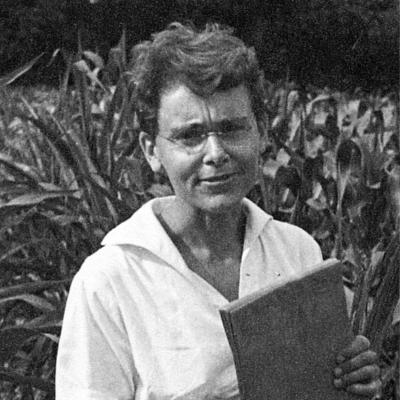Anúncios
Barbara McClintock was an American scientist who, through her groundbreaking work with corn, revolutionized genetics. The discovery of “jumping genes” or transposable elements in the early 20th century changed the way we understand genetics and evolution. Her work challenged established concepts and opened new pathways for scientific research.
Although her research was initially ignored, McClintock received international recognition for her discoveries. In 1983, she was awarded the Nobel Prize in Physiology or Medicine, solidifying her position as one of the most influential scientists in the field of modern genetics. Her research left a lasting legacy in biology, with implications that extend from agriculture to medicine.
Anúncios

How Barbara McClintock Revolutionized Corn Genetics
Barbara McClintock made groundbreaking discoveries while studying corn. She was the first to identify transposable elements, or “jumping genes,” which demonstrated that genes have the ability to move along the chromosome. This discovery challenged the conventional view that genes were fixed entities, profoundly altering the understanding of genetics.
Her research showed that genes are not immutable and can undergo rearrangements, impacting genetic inheritance. This opened the door to new approaches in biotechnology and genetic engineering, enabling the development of more resistant and productive crops. McClintock also suggested that the mobility of genes could be a mechanism of adaptation.
Her work, initially ignored, was recognized after years of meticulous research. This culminated in the Nobel Prize, acknowledging the importance of her discoveries for modern biology. McClintock’s legacy endures as a vital contribution to the study of plant genetics and its application in various fields.
McClintock not only transformed plant genetics but also provided insights into the understanding of evolution and genetic adaptation. Her research was crucial for understanding how organisms, including humans, can adapt to the environment through genetic modifications.
Benefits of Understanding Barbara McClintock and Corn Genetics Transforming Biology
Understanding Barbara McClintock’s work brings significant benefits to various areas of science. Her discovery of transposable elements has direct applications in genetic engineering, helping to create more resistant and productive plants. This is essential for ensuring food security and sustainable agriculture.
McClintock’s research also paved the way for the study of epigenetics, which investigates how environmental factors influence gene expression. This field has implications for adapting crops to climate change and other environmental challenges, contributing to crop resilience.
Furthermore, McClintock’s story serves as an inspiration for scientists, especially women in science. Her journey demonstrates that perseverance and innovation are crucial for scientific research, motivating future generations to follow their own paths and challenge established conventions.
McClintock’s work is also a reminder of the complexity and interconnectedness of biological systems. Her research showed that genetics is dynamic, and the study of genetic elements can help us understand broader evolutionary processes, benefiting conservation and biodiversity.
How Barbara McClintock’s Discoveries Impact Modern Science

The discovery of transposable elements transformed the understanding of genetic variability. This understanding is crucial for crop improvement and the development of new genetically modified organisms that can withstand environmental stresses and improve agricultural production.
McClintock’s work also revealed the mobility of DNA, a concept that opened new opportunities for genetic research. Studying the movement of genes allowed scientists to discover new genetic traits and mechanisms that contribute to phenotypic diversity.
McClintock’s discoveries are foundational to agricultural biotechnology, enabling the development of genetically modified organisms that meet global food security demands. This helps address the challenges of a growing world population and an increasingly unstable environment.
Her research also had a significant impact on the field of epigenetics. McClintock showed how environmental factors can influence gene expression and inheritance patterns, offering valuable insights into how organisms adapt to their environment.
How Barbara McClintock Revolutionized Corn Genetics
Barbara McClintock, an American scientist, made revolutionary contributions to the field of genetics, especially through her research on corn. Her work, which began in the 1920s, was pioneering in the understanding of genetic elements and their behavior within the genome. McClintock’s most significant discovery was the identification of transposable elements, often referred to as “jumping genes,” which revealed that genes could change positions on the chromosome. This concept fundamentally altered the understanding of genetic stability and inheritance, challenging the notion that genes were fixed entities.
McClintock’s research was initially met with skepticism and, for many years, was largely ignored by the scientific community. However, her meticulous experiments and innovative thinking eventually earned her recognition, culminating in the Nobel Prize in Physiology or Medicine in 1983. Her work is recognized as a milestone in modern genetics, influencing a wide range of fields from agriculture to medicine. By studying genetic mechanisms in corn, McClintock not only transformed our understanding of plant genetics but also provided insights that had lasting implications for the broader field of biology.
Benefits of Understanding Barbara McClintock and Corn Genetics Transforming Biology
Understanding Barbara McClintock’s contributions to corn genetics offers several benefits that extend beyond the realm of botany. First, her discovery of transposable elements has significant implications for genetic research and biotechnological applications. By understanding how genes can move and adapt within genomes, scientists can develop more efficient methods for genetic engineering and crop improvement. This knowledge is crucial for addressing challenges such as food security and sustainable agriculture in the face of a growing global population.
Second, McClintock’s work paved the way for advances in the study of epigenetics, which examines how environmental factors can influence gene expression without altering the DNA sequence. Her research on corn provided a model for understanding these complex interactions, offering insights into how organisms adapt to their environments. This understanding is vital for developing strategies to increase crop resilience to climate change and other environmental stresses.
Additionally, the recognition of McClintock’s contributions inspired a new generation of scientists, especially women in the fields of science, technology, engineering, and mathematics (STEM). Her story serves as a powerful reminder of the importance of perseverance and innovation in scientific research, encouraging young scientists to follow their passions and challenge existing paradigms. The legacy of her work continues to motivate and empower future generations to explore the mysteries of genetics and its applications.
Finally, understanding McClintock’s discoveries promotes a deeper appreciation for the interconnectedness of biological systems. Her research highlights the dynamic nature of genetics and the importance of considering the role of genetic elements in evolution and adaptation. This holistic perspective is essential for addressing complex biological issues and developing comprehensive approaches to conservation and biodiversity.
How Barbara McClintock’s Discoveries Impact Modern Science

Understanding transposable elements in corn genetics: McClintock’s work on transposable elements revolutionized our understanding of genetic variability. These elements can move within and between genomes, influencing gene expression and contributing to genetic diversity. This understanding has profound implications for plant breeding and genetic engineering, allowing scientists to harness these mechanisms for crop improvement.
The role of DNA mobility in genetic discovery: DNA mobility, as demonstrated by McClintock’s research, opened new avenues for genetic discovery. By studying how genes can relocate, researchers can uncover new genetic traits and mechanisms that contribute to phenotypic variation. This knowledge is crucial for developing crops with desirable traits, such as disease resistance and higher yields.
Applications of McClintock’s work in agricultural biotechnology: McClintock’s discoveries laid the foundation for numerous applications in agricultural biotechnology. Her insights into genetic mobility facilitated the development of genetically modified organisms (GMOs) that can withstand environmental stresses and increase food production. This technology plays a critical role in addressing global food security challenges.
Epigenetic insights from corn research: McClintock’s exploration of corn genetics provided valuable insights into the field of epigenetics. Her discoveries showed how environmental factors can influence gene expression and inheritance patterns, leading to a better understanding of how organisms adapt to changing conditions. This knowledge is crucial for developing strategies to enhance crop resilience and sustainability.
The importance of the Nobel Prize in Physiology for plant genetics: McClintock’s recognition with the Nobel Prize in Physiology or Medicine in 1983 marked a crucial moment in the field of plant genetics. It brought attention to the importance of plant research and the role of genetics in agriculture. This honor inspired further research and investment in plant science, leading to advances in crop improvement and biotechnology.
The lasting influence of McClintock’s research on future studies: The impact of McClintock’s research extends far beyond her lifetime. Her discoveries continue to influence contemporary studies in genetics, epigenetics, and biotechnology. As scientists build on her work, they are uncovering new genetic mechanisms and applications that will shape the future of biology and agriculture.
Did You Enjoy Learning About Barbara McClintock and Corn Genetics Transforming Biology?
Learning about Barbara McClintock and her transformative work in corn genetics is not only fascinating but also essential for understanding the foundations of modern genetics. Her discoveries reshaped our understanding of how genes function and interact, providing valuable insights that extend across various scientific disciplines. The legacy of her research continues to inspire and guide current and future generations of scientists as they explore the complexities of genetics.
As we delve into the implications of McClintock’s work, it becomes evident that her contributions are not merely historical milestones but vital components of ongoing research and innovation. Understanding corn genetics is not just about plants; it’s about unlocking the potential for advancements in agriculture, medicine, and environmental sustainability. McClintock’s legacy encourages us to appreciate the intricate connections within the biological world and the importance of scientific inquiry.
Frequently Asked Questions
Who is Barbara McClintock?
Barbara McClintock was a famous scientist. She discovered how genes change in corn. Her work greatly contributed to genetics.
What are corn genes?
Corn genes are units of inheritance. They control how plants grow and develop. Barbara McClintock studied these changes in genes.
How did Barbara McClintock transform biology?
Barbara McClintock transformed biology through her discoveries. She showed that genes can move. This changed our understanding of genetics.
What is the impact of her work on agriculture?
Barbara McClintock’s work helped improve crops. Today, we use what she learned to create stronger and healthier corn. This benefits many farmers.
Why is her research important today?
Barbara McClintock’s research remains important. She paved the way for modern studies in genetics. Her influence still affects biology and agriculture today.
